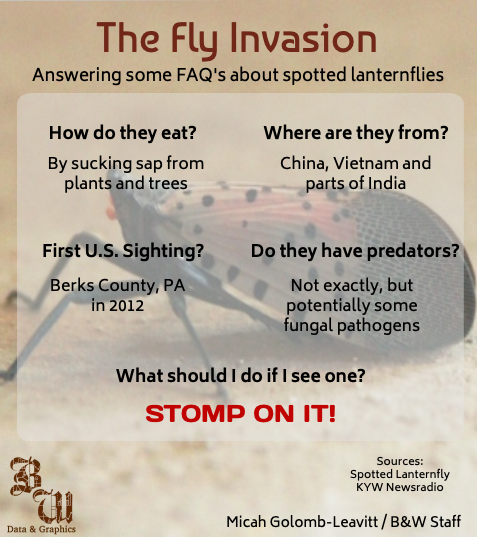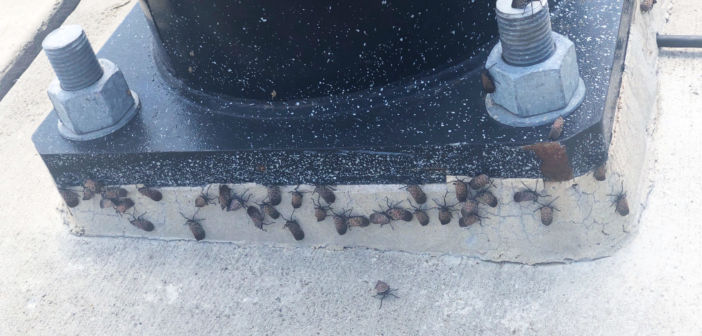The spotted lanternfly has taken over the Lehigh Valley, leaving most of the campus covered with the invasive species.
The lanternflies should be killed upon sight, as they can cause serious damage to trees, according to the Pennsylvania Department of Agriculture. Because students and staff are killing the flies, there are multiple spots on campus scattered with dead bugs.
University Architect Brent Stringfellow said in an email that the university does not plan to take many steps to mitigate the infestation anytime soon.
“The Commonwealth (of Pennsylvania) has established quarantines and encouraged everyone to kill lanternflies on sight, but there is no large-scale solution currently available,” Stringfellow said in an email. “There is a significant amount of research underway, and wehope that it will yield some options for us moving ahead.”
Stringfellow also said in an email that the large size of the campus makes it nearly impossible to get rid of the lanternflies at Lehigh completely. The use of pesticides is unlikely, he said, due to ecological and safety reasons.
“Much of our effort has focused on clean-up and removal of dead insects, encouraging everyone to keep stomping them out and following PA guidelines and recommendations,” Stringfellow said in an email.
Madeleine Pasda, ‘19, ‘20G, a graduate student assistant for the Office of Sustainability, said she often noticed maintenance workers power-washing the dead bugs away.
However, she said she noticed dead lanternflies covering the sidewalks outside E.W. Fairchild-Martindale Library a few hours later.
“I think it just really diminishes Lehigh’s beautiful campus a little bit,” Pasda said. “To clean up the actual dead ones, you would have to keep power-washing, but you can only do that so often with so many students back now, walking around and all.”
Andrew Januszak, senior computing consultant in the Library and Technology Services, said the current look of the campus can affect prospective students while touring.

“Students from the area might be more understanding, but students who aren’t from the area when they walk around and see it, they probably wonder,” Januszak said. “Nobody appreciates seeing a bunch of smashed bugs on the ground.”
Pasda said the sight of dead lanternflies offsets the beauty of the campus and the surrounding nature.
Robert Booth, an earth and environmental science professor, said the sight of dead lanternflies scattered across campus is “rather gross.”
“They’re an annoyance,” Booth said. “The broader concern is the impact they’re going to have, and we’re just not sure at this point how pervasive that impact will be. They’re certainly some trees up there on the mountain that are covered in spotted lanternflies.”
Stringfellow said in an email the lanternflies are drawn to a specific tree populated on South Mountain.
“We are assessing how best to deal with the significant population of Ailanthus trees on South Mountain, known as the ‘Tree of Heaven,’ as they are the favored tree for lanternflies, and the state has advocated for their removal,” Stringfellow said in an email.






Comment policy
Comments posted to The Brown and White website are reviewed by a moderator before being approved. Incendiary speech or harassing language, including comments targeted at individuals, may be deemed unacceptable and not published. Spam and other soliciting will also be declined.
The Brown and White also reserves the right to not publish entirely anonymous comments.
1 Comment
The closing to this story is very interesting: the prime target of the lanternflies is another invasive species, the so-called ‘Tree of Heaven’ that people have spent countless hours removing over the last 20 years or so.